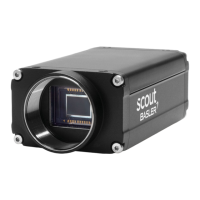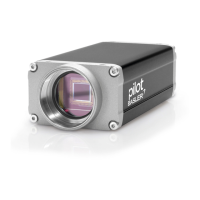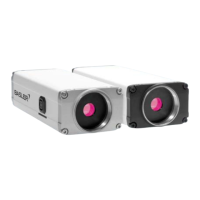AW00089317000 Camera Functional Description
Basler ace GigE 47
4 Camera Functional
Description
This chapter provides an overview of the camera’s functionality from a system perspective. The
overview will aid your understanding when you read the more detailed information included in the
later chapters of the user’s manual.
4.1 Overview Global Shutter With CCD
Sensor
Valid for All Models
Except
acA1280-60, acA1300-60, acA1600-60, acA1920-25, acA2000-50, acA2040-25,
acA2500-14
The camera with CCD sensor provides features such as a global shutter and electronic exposure
time control.
Exposure start and exposure time can be controlled
by parameters transmitted to the camera via the Basler pylon API and the GigE interface.
There are also parameters available to set the camera for single frame acquisition or
continuous frame acquisition.
via an externally generated "frame start trigger" (ExFSTrig) signal applied to the camera’s input
line. The ExFSTrig signal facilitates periodic or non-periodic frame acquisition start. Modes are
available that allow the length of exposure time to be directly controlled by the ExFSTrig signal
or to be set for a pre-programmed period of time.
Accumulated charges are read out of the sensor when exposure ends. At readout, accumulated
charges are transported from the sensor’s light-sensitive elements (pixels) to the vertical shift
registers (see Figure 29 on page 48 for cameras with a progressive scan sensor and Figure 30 on
page 49 for cameras with an interlaced scan sensor). The charges from the bottom row of pixels in
the array are then moved into a horizontal shift register. Next, the charges are shifted out of the
horizontal register. As the charges move out of the horizontal shift register, they are converted to
voltages proportional to the size of each charge. Each voltage is then amplified by a Variable Gain
Control (VGC) and digitized by an Analog-to-Digital converter (ADC). After each voltage has been
amplified and digitized, it passes through an FPGA and into an image buffer. All shifting is clocked
according to the camera’s internal data rate. Shifting continues in a row-wise fashion until all image
data has been read out of the sensor.

